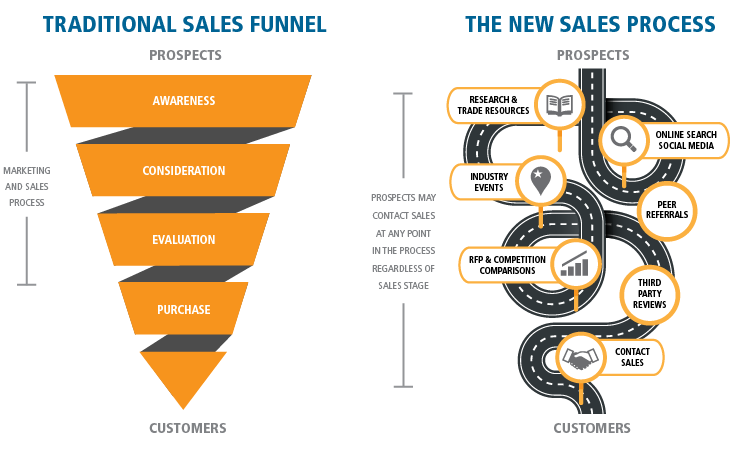
Written By: TMSA Staff | Jul 10, 2018 12:00:00 AM
Part 2 of a 2-part series on how emerging technologies, more immediate access to market data, and changing needs in transportation and logistics have become disrupters of the traditional sales funnel.
This Is What the New Sales Funnel Model Looks Like
Sales activities are becoming more personalized, complex, and dictated by today’s buyer of transportation and logistics products and services. As a result, buyers now hold more power, which is only going to increase as accessibility to market information expands. These changes in the buyer’s journey mean dramatic changes in the buying and selling processes. Buyers now can enter the sales pipeline at various points in the buying process.
These market changes have serious implications for all sales organizations — whether you’re a 3PL, motor carrier, railroad, ocean carrier, or technology innovator. Primary questions facing sales management include:
Adapting to this New Selling Environment
As mentioned earlier, buyers are taking more control of their purchasing journey and they’re entering and exiting the sales pipeline at various points in the buying process. No longer are buyers necessarily entering the sales process at the top of the funnel and following a consistent buyer’s journey. The new sales pipeline is made up of a complex web of individual buyer paths intersecting at the various sales and marketing touch points. This new reality is impacting sales in four primary ways:
1. Sales roles are morphing. In the past, sellers of transportation and logistics products and services were the main source of where buyers went to for information about the company, products/services and pricing. As more valuable decision-making information is readily available in a self-serve format (primarily online), sellers are having to do less around building awareness and consideration and more around “final solution building” and negotiation. The extent of this transformation depends on the complexity of the product or solution, but sales organizations should seriously consider this. If it is the case that sellers are having to do less “selling,” then sales leadership should consider re-evaluating their sales roles, overall sales and marketing structure, hiring profile, and compensation model. An interesting point: Inside Sales in transportation and logistics contributes 41 percent of sales revenue when deployed, according to the 2017 TMSA Sales & Marketing Metrics Study, which is a 2-point decrease
from the prior year. Outside Sales contributes 51 percent.
2. Marketing is becoming a bigger part of sales. Everyone wants to sustainably grow profit and revenue, but there is a critical element missing in most companies: Alignment. Unfortunately, there always have been challenges around sales and marketing working in concert — a common challenge in many industries. It’s no different in transportation and logistics.
Never has alignment been more important than in this new selling environment. In a world where buyers are empowered to determine their own buying path, marketers need to consider the complete end-to-end buying experience.
There’s no question that organizational alignment between sales, marketing and operations departments within transportation and logistics companies and their associates reduces friction and accelerates an organization’s growth and success. This is such an important goal that the theme of the 2018 TMSA Logistics Marketing & Sales Conference is focused on this “Align for Growth.” It takes place June 10-12 at the Westin Cape Coral at Marina Village in Fort Myers, Florida, and will provide attendees with practical ideas on how to overcome the challenges that prevent sustainable growth.
3. Formal sales processes are no longer enough. These days, no one can argue that sales organizations with defined sales processes achieve their sales goals more often than sales organizations without a formal sales process. A recent CSO Insights study found that 16 percent more reps hit quota with a defined sales process, according to the 2017 TMSA Sales & Marketing Metrics Study. However, as mentioned earlier the world of the buyer’s journey has changed. The difference now is that having a defined sales process is no longer adequate for success, “and in some cases may actually hinder sales performance.
Recalling that the sales funnel is now more like a complex web of different buyer pathways, buyer journeys are no longer necessarily linear. Therefore, your sales process shouldn’t be linear either. Rather, think of your sales process more modularly and in terms of playbooks. Consider developing “plays” based on scenarios such as: If a buyer is identified to be in this sales stage and has done Action X or Action Y,
then sellers should do Action Z. This new, tailored approach to the sales process is more dynamic and will enable sellers to meet buyers where they are and give them a more personalized experience.
4. Enablement tools are now more important. As the selling process becomes more complex, sellers now need tools that help simplify the complexity and still meet rising buyer expectations. That means tools that help sellers quickly understand where buyers are at in their buying journey and help them customize an approach relevant to the situation. Leading sales organizations invest in sales enablement tools because they know it is a big part of improving the performance of the middle-third of their sales force. Enablement technology has advanced significantly in the past five years and most of the solutions are cloud based, snap onto your existing CRM systems, and support dynamic sales processes.
An interesting point of fact: Approximately 60 percent of transportation companies use CRM of some sort, according to the 2017 TMSA Sales & Marketing Metrics Study. About 25 percent said they were considering deploying a new CRM system in the next 12 months — so the use and leverage of technology continues to be an important, growing strategy in this industry.
Tags: Sales

By JP Wiggins, Co-Founder and Vice President of Logistics at 3Gtms, where he manages channels and partnerships for the company. As part of a natural evolution of their existing offerings, many...